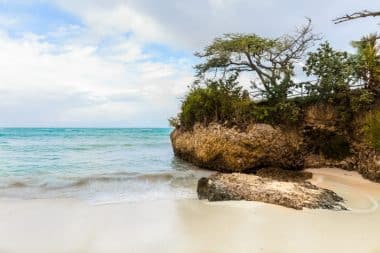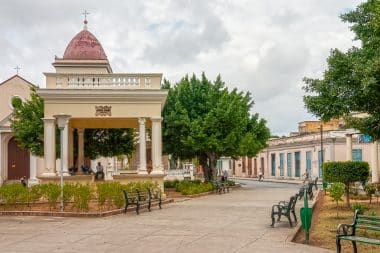Guardalavaca is a municipality in the province of Holguín, Cuba. The name literally means “guard the cow”. The name has evolved from the original place name Guardalabarca, which means “guard the boat”. The name is based on the fact that the bays there offered protection from sea pirates. Since 1990, Guardalavaca has increasingly been developed into a tourist resort. The main target group is divers who explore the breathtaking coral reef there.
The beautiful beaches of Guardalavaca
The town has beautiful beaches that invite you to relax, swim, swim, dive and snorkel. There are three in number: an approximately 700-metre-long beach in the west, a 450-metre-long beach to the east and the one-kilometre-long beach behind a small fishing harbour that extends to a small village. The water temperature in the region averages around 25 degrees Celsius. The hinterland is dotted with a Cuban coastal forest and has a rocky coastline.
Climate in Guardalavaca
Summer in Guardalavaca begins in June and ends in September. The climate in Cuba is tropical and the sun shines there all year round. It is an ideal destination for wintering. Temperatures fluctuate between 20 and 35 degrees Celsius throughout the year. In the winter months, less precipitation is generally to be expected than in summer.
The tourist center of Guardalavaca

The tourist center consists of three hotel complexes and the place where mainly the locals who work there live. To the west of the town is the three-star Club Amigo Atlantico hotel, which was renovated after Hurricane Ike. The pool area borders the sandy beach, which is about 750 meters long. To the west of the hotel there are shopping facilities, including a craft market. Behind the bungalows of the hotel is the Hotel Guardalavaca, where there is a swimming pool. Locals tend to spend their holidays here. However, the hotel also has rooms that meet European standards. With 4 stars, Hotel Brisas is considered the best hotel in Guardalavaca. The hotel building with its restaurant faces the beach. From the pools you can get directly to the sandy beach.
Excursions from Guardalavaca
If you want to take a break from relaxing on the beach, there are numerous leisure activities in Guardalavaca and the surrounding area. For example, you can visit the Chorro de Maita Indian cemetery or the landing site of Christopher Columbus, which is located on the Bahía de Bariay. For families with children, the aquarium in the “Parque Natural Bahía de Naranjo” is recommended. There is also a dolphin show worth seeing. You can also experience sea lions up close here.
A nice destination is the Museo El Chorro de Maíta, a museum about the life of the Indian-Cubans with an exhibition about original remains of indigenous people of the region. The museum is located south of the town of Yaguajay, where you will also find several restaurants and bars for lunch or dinner.
Specialities from the region
In Guardalavaca you also have numerous opportunities to taste typical Cuban specialties. The cuisine in the east is Caribbean-African, in contrast to the west of Cuba, which lives more from Spanish influences. The most important ingredients of Cuban cuisine there are Caribbean spices, African vegetables, rice (“arroz”) and black beans. The national dish of Cuba is called congris. It consists of rice with red beans. However, most specialties are prepared with a lot of meat. Cuba is best known for its rum with brands such as Ron Legendario or Ron Caney. On the sunny island, however, there is also excellent Cuban beer, such as Palma Cristal. Thick cigars are also a trademark of Cuba.
A tour in the province of Holguín

For those who want to make a somewhat longer round trip, the two national parks, the La Mensura National Park and the Pinares de Mayari National Park, are worth a trip. Here you can take a hike or a short walk in the wonderful nature. In the Pinares de Mayari National Park, there is a well-known waterfall to admire, El Salto de Guayabo, which is one of the highest in Cuba. Here the water rushes more than 300 meters into the depths. Characteristic of this nature reserve are the pine forests that stretch over the ridges. The region is also known for the country’s original coffee plantations.
The capital Holguín
The capital of the province of the same name Holguín is also worth seeing. There are some beautiful parks in the city that invite you to linger, such as the centrally located Galixto García Park. Art and culture lovers can also visit the beautiful Moncada and Bayado galleries or the city’s library. Holguín has a very beautiful cathedral that was built in 1720. It is called Catedral de San Isidro. A walk over 450 steps to the viewpoint on the Loma de la Cruz mountain reveals a wonderful, worthwhile view over the entire city, especially at sunrise and sunset, where you can end the evening wonderfully with a visit to the theater or cinema


